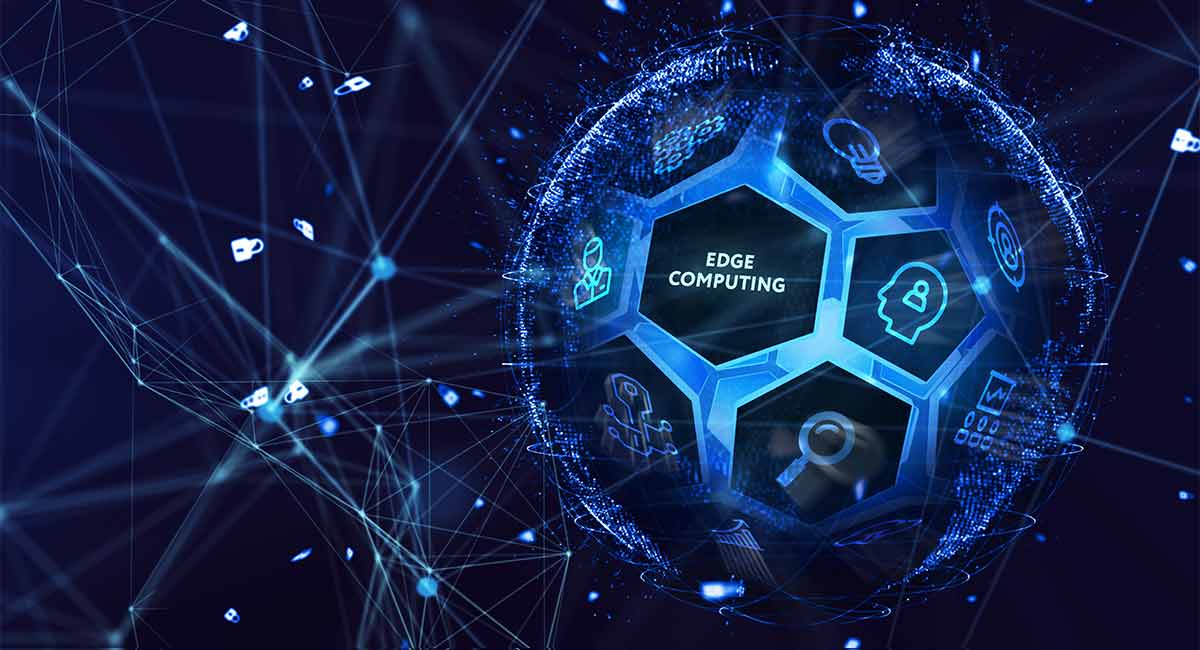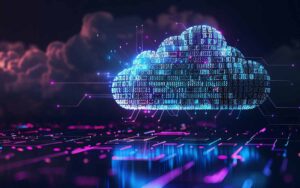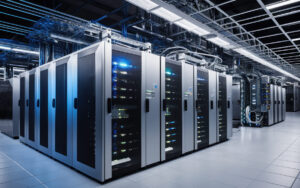Like most things in life, technology comes in waves. In the early 1960s, mainframe computers came onto the stage. These giant machines were meant to centralize everything efficiently in a controlled location. Then, personal computers and distributed computing became all the rage in the 1980s to the early 2000s — powered by on-premises server rooms and a reliable army of IT techs to manage those hyper-localized environments.
Then, in 2001, virtualization on x86 servers cracked by the founders of VMware happened, which enabled the advent of cloud computing as we know and consume it today. Yet the waves keep rolling. Enter edge computing, which enables distributed workloads while leveraging the cloud.
Let’s dig deeper into edge computing and how you can better understand today’s landscape and gain skills in this field through a cloud computing bootcamp.
What is Edge Computing?
Edge computing is a distributed computing paradigm that brings computation and data storage closer to the locations where it is needed to improve response times and save bandwidth. Unlike traditional cloud computing architectures that centralize processing and storage in a few large data centers, edge computing disperses these functions to the network’s periphery near the data source. This approach minimizes latency, or the delay in processing data, by reducing the distance it must travel.
Edge computing is particularly beneficial for applications requiring real-time or near-real-time analysis and decision-making, such as in Internet of Things (IoT) devices, autonomous vehicles, and smart cities technologies. By processing data locally, edge computing offers enhanced privacy and security, as sensitive information does not have to be sent over long distances to central servers. As the demand for immediate data processing and analysis grows, edge computing becomes an increasingly critical component of modern IT infrastructures.
Also Read: Industry Perspective: Cloud Computing in Healthcare
What is the Network Edge?
The network edge refers to the periphery of a network, where an enterprise’s network connects to the outside world, including the devices and local computing resources that are situated closer to the sources of data. In edge computing, the network edge is where data is generated and collected—such as through sensors, smart devices, or other endpoints—before it is processed. This could include various environments, from industrial sites with machinery sensors to urban areas with traffic management systems and individual homes with smart appliances.
The concept of the network edge is crucial because it represents the frontline in data processing and analysis, enabling immediate actions based on the data collected. Businesses and service providers can significantly reduce latency, enhance data processing speeds, and improve overall network efficiency by situating computing resources at the network edge. The network edge thus serves as a bridge between the digital and physical worlds, enabling a seamless flow of information and facilitating smarter, more responsive systems across various sectors.
How Does Edge Computing Work?
Edge computing works by decentralizing data processing, moving it from centralized data centers to the outer edges of the network, closer to where data is generated. This shift in computing architecture is designed to address the challenges posed by the massive influx of data from IoT devices, mobile applications, and other digital technologies that require quick processing and response times. Here’s a simplified overview of how edge computing operates:
- Data Generation: The process begins at the network edge, where sensors, smartphones, cameras, or other IoT devices generate data. These devices are often located in remote or distributed environments, generating vast amounts of data that must be processed in actual or near-real times.
- Local Processing: Instead of sending all this data directly to centralized cloud data centers, edge computing infrastructures process much of this data locally, at or near the generation source. Depending on the application’s requirements, this can involve simple data analysis, filtering, or complex processing tasks. Edge computing devices can range from small, simple processors embedded in IoT devices to more powerful edge servers on-premises.
- Decision Making: By processing data locally, edge computing allows for immediate decision-making and action without significant latency. For example, in a manufacturing environment, an edge computing system could instantly analyze data from machinery sensors to identify and address operational issues before they escalate without waiting for data to be sent to and processed in a distant data center.
- Data Transmission: Only the necessary or relevant data—such as insights, summaries, or alerts generated from the local processing—might be sent back to the central data centers or cloud for further analysis, long-term storage, or global insights. This selective transmission reduces bandwidth usage and costs and mitigates potential network congestion.
- Integration and Action: The insights generated by edge computing can be integrated into broader business systems or trigger immediate actions, enhancing operational efficiency, improving customer experiences, and supporting real-time control over distributed operations.
In essence, edge computing redefines data processing workflows, emphasizing proximity, immediacy, and efficiency to cater to the demands of modern digital applications and services.
Also Read: What is Cloud Computing Security?
What Are the Basic Components of Edge Computing?
Edge computing comprises several vital components that work together to process data closer to its source, thus reducing latency and bandwidth use while increasing efficiency and responsiveness. Understanding these components provides insight into how edge computing ecosystems function and how they can be leveraged for various applications. Here are the primary components of edge computing:
- Edge Devices: These are the physical devices at the “edge” of the network that generate data. They can be anything from IoT sensors, smartphones, and security cameras to more specialized equipment like autonomous vehicles or industrial machines. Edge devices often have computing capabilities to perform basic data processing tasks locally.
- Edge Nodes/Gateways: As intermediaries between edge devices and the wider network or cloud, edge nodes or gateways provide additional processing power, data aggregation, and local data analysis. They can filter and preprocess data from edge devices before it’s sent to central servers, reducing the volume of data transmitted and ensuring only relevant information is forwarded.
- Edge Data Centers: These are smaller, localized data centers closer to the edge devices. Edge data centers perform more substantial data processing and storage tasks, handling data from multiple edge nodes or gateways. They offer quicker response times than traditional, centralized data centers by being geographically closer to the data source.
- Network Infrastructure: The connectivity layer links edge devices, nodes, and data centers. This includes traditional networking equipment like routers and switches and modern networking technologies such as 5G, crucial for high-speed, low-latency communication.
- Cloud Integration: While edge computing processes data locally, it often integrates with cloud computing resources for further analysis, larger-scale processing, and storage. This component ensures that edge computing does not exist in isolation but is part of a comprehensive data processing framework.
- Software and Applications: This includes the operating systems, management software, analytics, and applications that run on edge devices, nodes, and data centers. Software is essential for the edge computing infrastructure’s configuration, operation, and security, enabling data processing, decision-making, and the execution of specific tasks based on the analyzed data.
- Security Features: Given the distributed nature of edge computing, security components are crucial. This includes physical security for devices and data centers, cybersecurity measures for data protection, and secure communication protocols to safeguard data transmission across the network.
Together, these components form the backbone of edge computing, enabling it to efficiently process and analyze data close to its source, support real-time decision-making, and reduce reliance on central data centers.
Benefits of Edge Computing
Edge computing offers many benefits that address the evolving demands of modern digital applications, particularly those requiring real-time processing, reduced latency, and improved operational efficiency. Here are some of the key benefits of implementing edge computing:
- Reduced Latency: By processing data near its source, edge computing significantly reduces the time it takes for devices to receive a response to their data requests. This is crucial for applications where real-time analysis and decision-making are essential, such as autonomous driving, real-time monitoring, and interactive gaming.
- Bandwidth Savings: Edge computing minimizes the need to send vast amounts of data across the network to a central data center. Analyzing and processing data locally and sending the necessary information to the cloud reduces bandwidth usage and associated costs while alleviating network congestion.
- Enhanced Security and Privacy: Processing data locally reduces the exposure of sensitive information to potential vulnerabilities across the network. Edge computing allows data to be anonymized or encrypted locally before being sent over the network, enhancing privacy and security.
- Improved Reliability: By decentralizing processing tasks, edge computing reduces dependency on central data centers and cloud services, which can be affected by downtime or connectivity issues. Local data processing ensures continuous operation even during network failures, making systems more reliable.
- Scalability: Edge computing allows organizations to scale their IT infrastructure horizontally by adding more edge devices and nodes as needed. This scalability is more cost-effective and flexible than scaling traditional, centralized data centers.
- Efficient Use of Cloud Resources: By processing data locally and only sending essential information to the cloud, edge computing ensures that cloud resources are used more efficiently. This can lead to cost savings and improved performance for cloud-based applications.
- Real-Time Insights and Action: Edge computing enables immediate analysis and action based on collected data. This capability is invaluable for manufacturing, healthcare, and retail industries, where real-time insights can lead to operational improvements, enhanced customer experiences, and better decision-making.
- Localized Data Processing: In scenarios where data sovereignty and compliance are crucial, edge computing allows data to be processed within the same jurisdiction where it is generated, complying with local data protection regulations.
Overall, edge computing represents a shift towards more intelligent, responsive, and efficient IT infrastructure capable of supporting the next generation of digital services and technologies.
Limitations of Edge Computing
While edge computing offers significant benefits for real-time data processing and analysis, it also has limitations and challenges. Understanding these limitations is crucial for organizations considering adopting edge computing architectures. Here are some of the notable limitations of edge computing:
- Resource Constraints: Edge devices and nodes often have limited processing power, memory, and storage compared to traditional data centers or cloud environments. This can restrict the complexity of the tasks they can perform and the amount of data they can handle, potentially impacting the effectiveness of edge computing solutions in resource-intensive applications.
- Management Complexity: Deploying and managing a distributed network of edge devices and infrastructure can be more complex than managing centralized data centers. This includes challenges in deploying updates, monitoring performance, and ensuring security across numerous devices and locations, which can increase operational overhead.
- Security Risks: While edge computing can enhance data security by processing data locally, the distributed nature of edge devices also expands the attack surface for potential cyber threats. Each device can represent a point of vulnerability, requiring robust security measures to protect against breaches and ensure data integrity.
- Interoperability Issues: Given the wide variety of edge devices, standards, and technologies involved in edge computing, interoperability can be a significant challenge. Ensuring seamless communication and integration between devices, platforms, and the cloud requires careful planning and standardization.
- Cost Considerations: Initial setup costs for edge computing infrastructure can be high, especially for organizations transitioning from traditional cloud-based or centralized models. This includes the cost of edge devices, local data storage solutions, and developing edge-specific applications and services.
- Limited Scalability of Individual Devices: While edge computing can scale by adding more devices and nodes, individual edge devices have inherent limitations in their scalability due to their size, power, and capacity constraints. This can limit the scope of tasks they can handle independently.
- Data Consistency and Synchronization: Ensuring data consistency across distributed edge devices and the central cloud or data centers can be challenging, especially in environments where data is constantly being updated. Synchronizing this data without significant latency or bandwidth costs requires sophisticated coordination and data management strategies.
- Environmental and Physical Risks: Edge devices are often deployed in uncontrolled environments, exposing them to physical damage, theft, or environmental hazards. This requires additional physical security and durability considerations, potentially increasing costs and complexity.
Despite these limitations, the benefits of edge computing in reducing latency, improving efficiency, and enabling real-time processing for numerous applications often outweigh the challenges. Organizations can mitigate these limitations through careful planning, robust security measures, and selecting the right technologies and partners for their edge computing deployments.
Also Read: How to Become a Cloud Engineer? A Complete Guide
Industry Use Cases for Edge Computing
Edge computing has found its place across various industries, revolutionizing how data is processed, and decisions are made in real-time. Here are several key industry use cases that showcase the versatility and transformative potential of edge computing:
- Manufacturing: In smart factories, edge computing is used to monitor and control manufacturing processes. It enables predictive maintenance by analyzing data from machinery sensors on the factory floor identifying potential issues before they lead to downtime. Edge computing also supports advanced robotics and automation, improving efficiency and reducing operational costs.
- Healthcare: Edge computing is critical in healthcare by facilitating real-time patient monitoring and telemedicine. Wearable devices and bedside monitors can process data locally to provide immediate alerts and insights, improving patient care and outcomes. In emergency situations, edge computing ensures that vital data is processed and acted upon quickly, even in environments with poor connectivity.
- Retail: In the retail sector, edge computing enhances customer experiences through personalized interactions and efficient operations. For example, smart shelves with edge computing capabilities can monitor inventory levels in real time. At the same time, edge-enabled cameras can analyze customer traffic and behavior to optimize store layouts and product placements.
- Transportation: For transportation and logistics, edge computing enables real-time fleet management, route optimization, and vehicle predictive maintenance. In autonomous vehicles, edge computing processes vast amounts of data from sensors and cameras on board in real time, which is crucial for safe navigation and decision-making on the road.
- Smart Cities: Edge computing is integral to developing smart cities, supporting applications such as traffic management systems, public safety monitoring, and energy distribution. By processing data locally, smart city technologies can respond more quickly to changes, enhancing residents’ efficiency and quality of life.
- Energy: In the energy sector, edge computing facilitates the monitoring and managing of renewable energy sources, like wind turbines and solar panels. It enables real-time data analysis for optimizing energy production and distribution, improving grid reliability and efficiency.
- Telecommunications: With the roll-out of 5G networks, telecommunications companies are leveraging edge computing to reduce latency and handle the increased data throughput required by new applications, such as augmented reality (AR) and virtual reality (VR), ensuring smoother and more engaging user experiences.
- Agriculture: Edge computing supports precision agriculture by processing data from on-site soil sensors, drones, and satellite images. This enables farmers to schedule real-time irrigation, fertilization, and pest control decisions, leading to increased crop yields and more sustainable farming practices.
These use cases illustrate the broad applicability of edge computing, driving innovation and operational improvements across sectors. By enabling real-time data processing and analysis, edge computing is at the forefront of digital transformation, allowing businesses and societies to become more responsive, efficient, and connected.
Edge Computing Examples in the Real World
Real-world examples of edge computing demonstrate its impact across various sectors, highlighting how it’s being implemented to enhance efficiency, improve decision-making, and solve industry-specific challenges. Here are a few notable examples:
- Smart Traffic Management Systems: Cities like Barcelona have implemented smart traffic management systems that use edge computing to analyze data from traffic cameras and sensors in real time. This allows for immediate adjustments to traffic signals and alerts, reducing congestion and improving road safety.
- Remote Oil Rig Monitoring: Oil and gas companies use edge computing for remote monitoring and predictive maintenance of offshore oil rigs. By processing data directly on the rig, they can detect equipment anomalies early, reducing the risk of failures and costly downtimes.
- Retail Customer Experience Enhancement: Retail giants like Walmart have deployed store edge computing solutions to enhance customer experiences. By analyzing data from in-store cameras and sensors at the edge, these systems can optimize store layouts, manage inventory in real-time, and offer personalized promotions to customers as they shop.
- Healthcare Wearables and Monitoring Devices: In healthcare, edge computing is used in wearable devices and remote monitoring equipment to process health data on the device itself or close to the patient. This enables immediate alerts for healthcare providers in critical situations, such as detecting falls in elderly patients or monitoring vital signs for abnormalities.
- Autonomous Vehicles: Companies in the automotive industry, like Tesla, are leveraging edge computing in autonomous vehicles. These vehicles process vast amounts of data from onboard sensors and cameras in real time, essential for making split-second driving decisions without relying on distant data centers.
- Agricultural Drones and Sensors: In agriculture, drones and IoT sensors equipped with edge computing capabilities are used for monitoring crop health, moisture levels, and pest presence. This allows for precise, real-time decision-making regarding irrigation, fertilization, and pest control, leading to more efficient and sustainable farming practices.
- Manufacturing Predictive Maintenance: Manufacturers, including Siemens, use edge computing to implement predictive maintenance on their machinery. By analyzing data from sensors on equipment in real time, these systems can predict when parts will likely fail and schedule maintenance before breakdowns occur, significantly reducing downtime and maintenance costs.
- Smart Energy Grids: Energy companies use edge computing to create smarter energy grids. These grids can balance supply and demand in real time, integrate renewable energy sources more efficiently, and automatically reroute power during outages, enhancing energy efficiency and reliability.
These examples showcase the versatility and transformative potential of edge computing across industries, driving innovation and efficiency by enabling more intelligent, responsive, and autonomous systems.
Learn More About Cloud and Edge Computing
The fact is that cloud and edge computing are used in conjunction today. It makes a ton of sense why. If you’re interested in a career in this field, consider training through a comprehensive cloud computing program that provides practical training and an industry-recognized certificate for your resume.
You might also like to read:
Top Cloud Computing Career Paths to Explore
Different Types of Cloud Computing: A Comprehensive Guide
What is AWS EC2? A Comprehensive Guide






